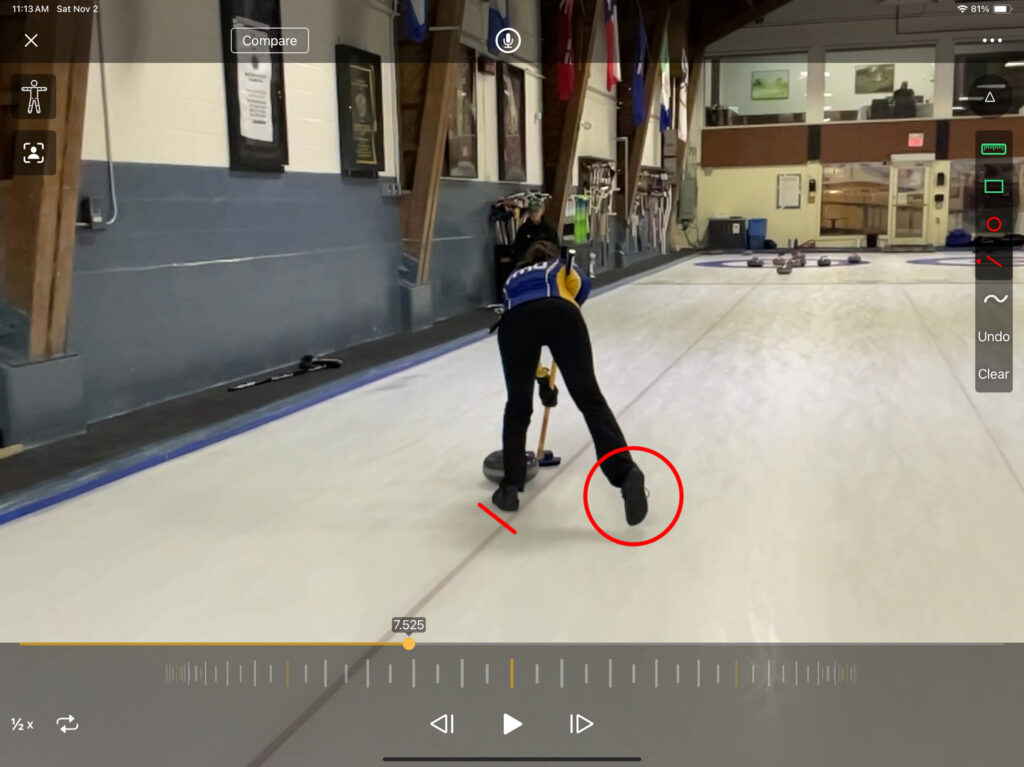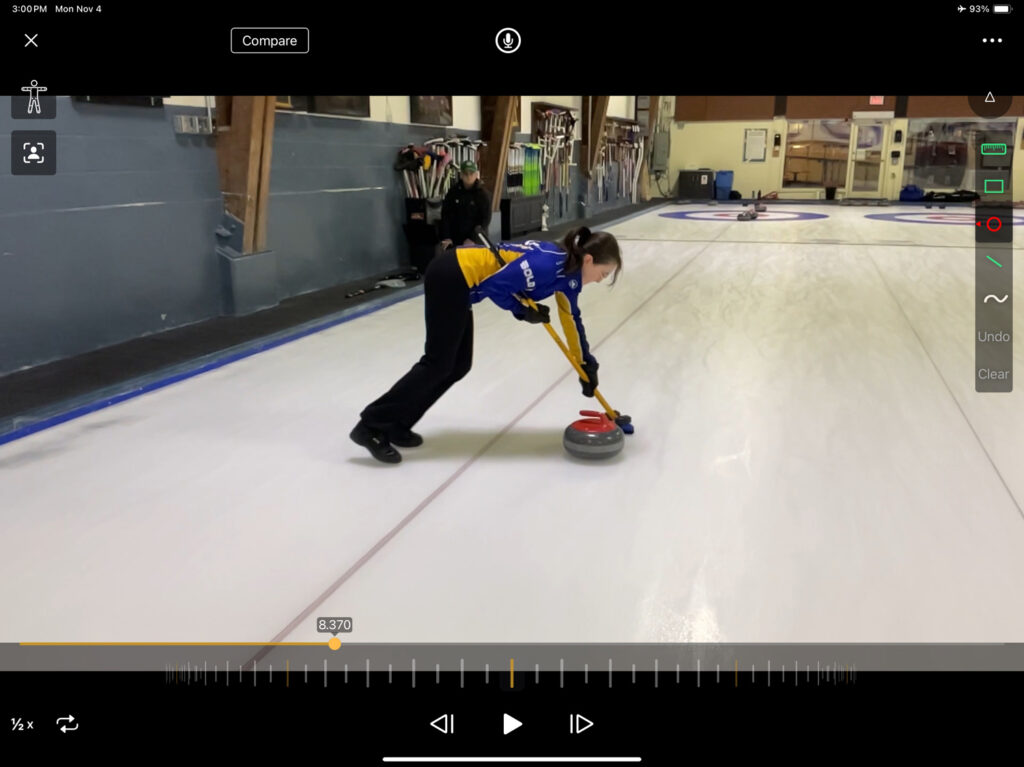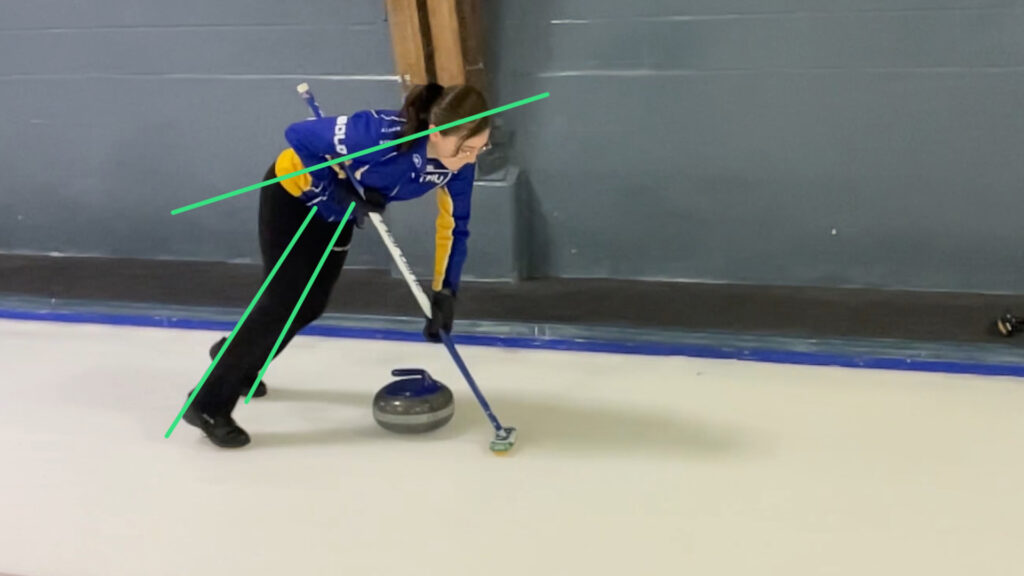While an instrumented brush is ideal for capturing the force profile of an athlete, video analysis is equally essential so that the athlete can get visual feedback on their technique, and know if they have made the correct and desirable adjustments to their technique on subsequent bouts.
In this article, I’m going to use Celeste Gauthier, of Team Émilie Lovitt and Toronto Metropolitan University, as a model to describe some useful tips in video analysis of brushing.

What is OnForm?

OnForm (formerly Hudl Technique) is a coaching application that supports recording and playback of video along with the ability to annotate video with diagramming or audio overlay to provide coach feedback. Videos are stored in the cloud (instead of on your device) and can be shared with athletes (or other coaches) on a coach license.
In addition, OnForm now supports multi-camera inputs so one can capture simultaneous video from different camera angles, similar to other apps such as Switcher Studio. However, as OnForm permits slow-motion recording and playback, line and audio annotation, and easy cloud sharing, in my experience OnForm provides considerable functionality advantages over Switcher Studio for reduced cost, and additionally supports both Apple and Android systems.
Angle of view

Side view.

Rear view.
Ideally, in brushing analysis one would like to have multiple angles of view with which to provide feedback for an athlete. All three angles can be useful:
- From behind: to capture the athlete’s head-to-toe orientation in a snowplough position, or to capture the movement of the feet in any stance;
- From the side: to provide feedback on footwork, shoulder and hip orientation, and arm and grip positions, along with the relative position of the brush head to the athlete’s torso; and
- From the front: again to determine head-to-toe alignment, but also to provide feedback on the angle of attack of the brushing stroke and if the stroke is, indeed, in front of the running band of the stone.
To some extent the most desired angle of view depends on the specific brushing technique and the angle of attack. For snowplough (brushing directly behind the stone) a side view is arguably the best angle, although videoing from the side often requires an empty adjacent sheet.
Using slow motion
Slow motion analysis is critically necessary in curling delivery analysis, and so it is also necessary in brushing analysis. Much information can be gleaned from slow-motion capture and playback, especially when analyzing an athlete’s footwork. We’ll use Celeste, brushing in a snowplough position, to illustrate.
In the full-speed video at right, Celeste is brushing a stone from a snowplough position. At nearly 40% normalized mean force, Celeste is already an accomplished brusher and is in the first quartile for her gender and LTCD stage. There are a number of excellent characteristics of Celeste’s technique: shoulders are higher than her hips, feet remain behind her hips much of the time, and her grip on the brush, particularly with her right hand at top, is in a good position.
Nonetheless, there are some elements of Celeste’s technique that could be improved. Because Celeste is lightweight, being technically perfect is important in order for her to maximize her vertical force down the brush handle, since a curling stone doesn’t care who holds the brush as it travels down the sheet.
The video clip at right is the same as the bout above but this time in slow motion. In slow motion, some sub-optimal placement of her feet, along with the placement of the brush head, provide some clues for further improvement.
Full-speed playback.
Slow motion playback.
Using annotations

By slowing the video playback to slow motion, one can see that an element of Celeste’s technique that can be improved is her footwork, which is harder to discern at full speed. With her footwork, Celeste has a tendency to do two things in the snowplough stance:
- Over-extend either foot behind her, raising the foot off the ice causing a “plant” of the other foot; and
- As the stone slows, she permits both feet to get more beneath her, which shifts some of her centre of gravity backwards and away from the brush, reducing her vertical force output.


Another useful annotation provided within OnForm is 2-D markerless motion capture. Turning this on permits OnForm to analyze the athlete’s body movements to create outlines of the athlete’s limbs and torso throughout the video, and can aid in the analysis of the athlete’s biomechanics. This is particularly useful in analyzing brushing, as seen in two of the images above. Occasions where Celeste over-extends her leg, lifting her foot completely off the ice, become much more obvious.
Providing feedback
As mentioned above, Celeste is an accomplished athlete who is already in the first quartile of brushing performance for her gender and LTCD stage, and there are many elements of her technique that are excellent, achievable through her commitment to fitness, particularly core strength.
Improving her footwork in practice, through the use of drills and additional video feedback, accompanied with an instrumented brush (I use a CurlSmart instrumented brush in my work) will result in improved levels of sustained forces on the brush, and yield overall improvements in the force that she is able to generate. With some dedicated practice I fully expect Celeste to achieve top-percentile results in the very near future.
